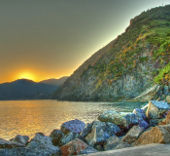Cinque Terre

The coastal landscape of the Cinque Terre is a continuous of spectacular sights characterized by wild nature and an explosion of colours, also thanks to the work of men, who have skilfully transformed it into a marvellous garden over the centuries, with an amazing array of terraced vineyards and olive groves descending to the sea.
This stunning landscape is divided into separate areas, from the sea level, dotted with jagged rocks, up to the cultivated area, with its characteristic “terraces” created by the work of men over the centuries, featuring an endless succession of dry stone walls (their total length is about 7.000 kilometres and if they were lined up together, they would surpass the Great Wall of China in length!).
Moving our gaze uphill, we can notice the olive trees belt and, right above, the lush Mediterranean vegetation made of shrubs and aromatic herbs.
Over this belt stand marine pines, oaks and chestnut trees.
It seems like nature has unveiled all its creativity and fantasy in the Cinque Terre; here, in fact, over one thousand types of plants can be found, accounting for about a sixth of the national flora.
However, all this was not achieved with ease; people slowly reclaimed each inch of land for their cultivations, engaged in a constant fight with nature; just think about the amazing work of digging in the rock and build dry stone walls to create terraces where lemon and olive trees and vines are cultivated, etc.
Another peculiarity of this area is the extensive network of walking trails and mule tracks which, unravelling for miles and miles, connect the five villages of the internationally-renowned “Cinque Terre” as well as linking them with other inland towns and the villages of the Val di Vara.
These ancient trails constituted the only commercial route between the two sides of the mountains, where cereals, meat and other products transited, while the fishing villages would send salt, fish, wine, etc.
The wild landscape of the Cinque Terre has been preserved intact also thanks to centuries of total isolation from civilization; only around the end of the nineteenth century indeed these areas were linked to the rest of civilization by the railway with the construction of the Genoa/La Spezia railroad, which is still the best and fastest option to reach and visit these enchanting villages.
However, the best way to visit and enjoy them is on foot, walking along the trails on the coastline, hillside or the ridge.
Frequent and regular trains depart from La Spezia to the Cinque Terre.
The first village you meet is Riomaggiore and it can be reached in just 7/8 minutes by train, which is also the ideal starting point to discover the whole area.
If weather conditions allow it, in the summertime you can reach the Cinque Terre also by boat, thanks to a ferry service from La Spezia and then, with stops or changing boat in Portovenere, to all 5 Terre.
The Cinque Terre became a UNESCO World Heritage Site in 1997, one of the most beautiful places in the world and worth to be preserved; the Cinque Terre National Park was created later on in 1999 to regulate, protect, preserve and recover this unique environment.
Within its territory, a Protected Marine Area was established to protect and preserve waters and shores of these wonderful but fragile places.
Some years ago, the Cinque Terre waters were included in the International Sanctuary of Cetaceans.
In the waters off these villages, in particular off Punta Mesco, in front of Monterosso, it is easy to sport dolphins, tuna and swordfish.
In addition, over a thousand whale sightings have been recorded over the last few years.
The villages that make up Cinque Terre are: